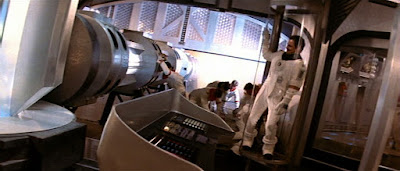 |
| Faci-NOPE. |
This is relevant to game design because I could run a game set in Middle Earth or Mythic Greece using D&D with no real problems. I could not run Star Wars using Star Trek RPG rules or vice versa. Warp Drive, Transporters, Lightsabers, The Force - I would spend enough time in conversions from one system to the other that I may as well just get both games.
While there are more universal SF RPGs out there (and GURPS, of course) this usually puts the problem on the GM. Systems such as STAR HERO for example make it possible to build virtually anything you can imagine - at the expense of having to build everything you imagine. This kind of time sink can be more intensive than actually learning multiple game systems and encourage GMs to purchase multiple games.
I intend to address both problems.
 |
| Yes, I know what it means. |
The inspiration for this part of Project NEPTUNE comes from the same place I get most of my inspiration: Winchell Chung's Project Rho. While most famous among SF aficionados for Atomic Rockets, Chung's Project Rho has other treasures for those who seek them. Two of those treasures are going to be the key to making space travel and combat interesting, full of player agency, easy for GMs to prep and run, and useful across multiple franchises.
INFLUENCE DIAGRAMS
Project Rho has a whole section on cool game mechanics that bares careful study. Among them is a single article by Neel Krishnaswami that can, as of 2022, only be found on Project Rho. I'll give a high pass of what's important for us here, but the full article is excellent and I lament there was no follow up.
The example in the article addresses Star Trek in particular but the core idea applies to any technology. By breaking down a SF tech like warp drive or what have you into individual systems or components, you can build a causal influence diagram that gives the player details that actually matter. This can be presented as a handout (or card) to the players and used by character to repair tech, work with tech and generally make the tech more real at the table.
Since I'm working on the idea of Crew as Damage Control, I'm naturally drawn to this notion.
 |
| The rules for this - |
What makes this work across multiple franchises is that the procedure of using the Causal Influence Diagram is universal while the tech itself is modular. For example, If I were playing a Star Trek style game, I'd want a CID of a warp drive. It would have bubbles like Matter/Antimatter containment, Warp Core, Plasma Conduits and Warp Coils. My Engineer character would use that to troubleshoot damage and tell the captain that She cannae take much more o' this.
 |
| - are the same as the rules for this. |
So when folks on Twitter ask me if the work I'm doing on space travel and combat can apply to their favorite game, I can say with confidence that yes, yes it will.
Using the Analog Database makes this work even better. Any ship system, from any franchise can not only be diagrammed, but the cards stored in the same stacks and simply filtered by search term. Packaged and sold individually, a deckof cards inspired by a given franshise could contain the tech, character backgrounds, and unique rules required to fully use the setting without needing an entirely new game.
BEYOND TECH
I found another article on Project Rho that brings home to me the potential of this idea. Ron Edward's The Sorcerer's Soul was also praised for it's use of relationship maps. I got a copy of the book and perused that section - it didn't take me long to realize that Relationship Maps and Causal Influence Diagrams can be considered the same thing.
So if CIDs can be used for physical objects and networks, and also for social relationships and people, could it also be used for ideas or intellectual pursuits? Justin Alexander has pretty much proven it can - and provided excellent advice on how to use them as well.
For me this means that not only can the conflict rules in SACRIFICES be used for physical, mental and social conflicts, CIDs can be used for physical, mental and social networks as well
The system would be unified across all three attributes - which means it's unified across the entire game. Across any game I want to make.
 |
| Still know what it means. |

No comments:
Post a Comment
Questions, comments, criticisms? All non-Trolls welcome!